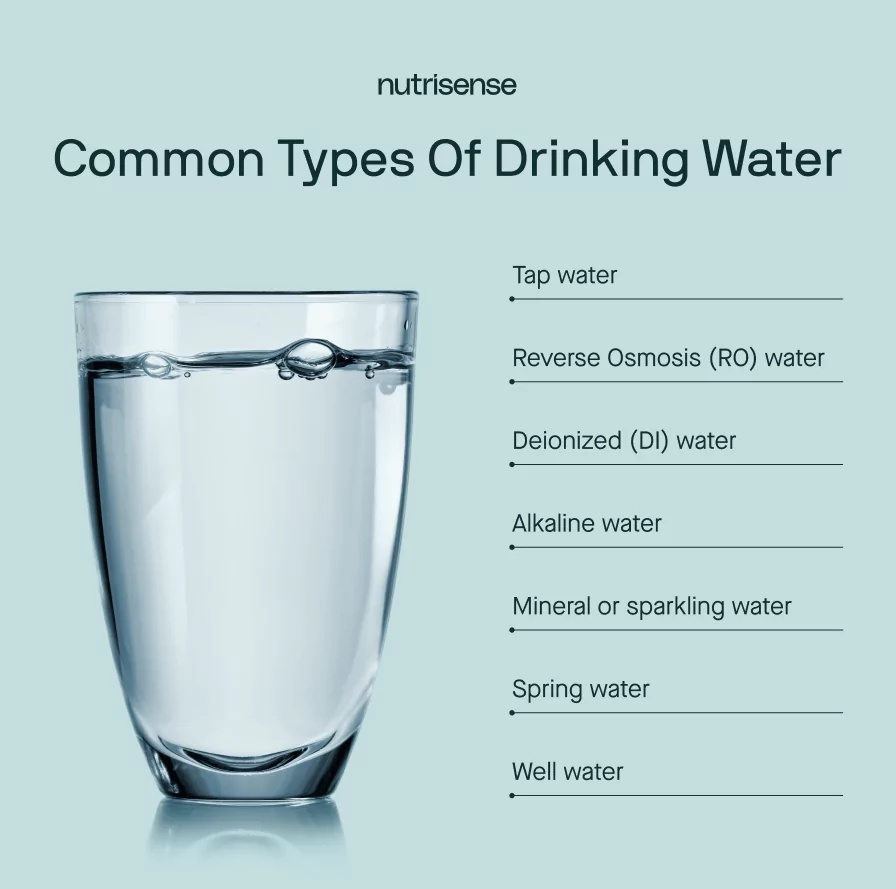Types of Drinking Water: Which is Healthiest?

Key Takeways
Did you know that water comprises about 50-60 percent of your total body weight? That’s right—in fact, every system in your body needs water to function and survive.
While it may be common knowledge that drinking enough water is important, you may have noticed that there are dozens of different types of water available these days. From tap water to purified water to distilled water, you have more water options to choose from than ever before.
But do certain types of water have more health benefits than others? And are there any you may actually want to avoid?
In this article, we’ll explore the many different types of drinking water and their potential benefits and downfalls. Read on to learn more!
What is the Best Type of Water to Drink?

Water supports the function of all of our organs. It’s critical for:
- Removing waste from your body
- Regulating your body temperature
- Maintaining your blood pressure and blood volume
- Lubricating the joints and aiding in digestion
- Helping to absorb and transport nutrients throughout the body
- Supporting skin health
- Assisting in the chemical reactions of your metabolism
There are dozens of different purification methods and filtration systems for drinking water out there. Some types of water may contain a higher mineral content, which can be beneficial to your health, while others may increase your risk for certain conditions.

At this time, there is no one “healthiest water” variety, and as long as your water is clean and safe to drink, the best water type for you may depend on your specific needs and what type is available to you.
But, there are many water brands out there that claim that they provide the healthiest variety of water, so let’s break down each of these common types and the benefits they may provide.
1) Tap Water

Tap water is the municipal drinking water that’s typically piped into homes and businesses from a central water treatment facility and comes out of your faucet. Depending on the water supply where you live, some types of tap water can have added fluoride and the water taste may be distinct.
The water quality, purification, and treatment process may vary depending on your community and location, but it typically consists of these treatment steps that add minerals, remove solids, filter, and disinfect the water:
- Coagulation
- Flocculation
- Sedimentation
- Filtration
- Disinfection
2) Reverse Osmosis (RO) Water

Reverse osmosis, or RO, is a method that passes water through a semipermeable membrane to remove minerals, molecules, and other impurities from drinking water. This purification process removes a high percentage of these compounds, which may include essential minerals like magnesium and calcium.
For this reason, some researchers have expressed concern about the potential negative health effects or environmental consequences of this demineralization of water. Some RO treatment systems will “remineralize” water by adding some beneficial minerals back into the water, but it has varying levels of efficacy.
3) De-ionized (DI) Water

De-ionized water has been treated to remove all ions, which are particles with a negative or positive electrical charge. Typically, that means all of the dissolved mineral salts in the water have been removed.
This treatment was initially used to create more controlled conditions in laboratory settings for the biotech and pharmaceutical industries. As with reverse osmosis treatments, there may be some reason to consider potential health concerns associated with demineralization of water.
4) Alkaline Water

Alkaline water is a type of water that has a higher pH level than regular drinking water. Normal drinking water generally has a neutral pH of seven, while alkaline water typically has a pH of eight or nine.
Drinking natural alkaline water such as spring water is generally considered safe because it contains natural minerals. While certain health claims have been made in favor of alkaline water, there is currently little to no strong evidence to support them.
Although a variety of bioactive functions have been reported in animal studies, the effect of alkaline water on lifespan and longevity in the human body is still unknown. One Japanese study, however, reported positive effects on digestion and exercise performance in humans from alkaline water use.
Despite this, it’s important to note that researchers reported a conflict of interest: they received funding from one of the companies that produces the AEW water devices. Other similar studies have received funding from the manufacturers of these alkalizing water systems.
5) Mineral or Sparkling Water

Mineral water typically comes from a “natural” source like a natural spring and can either be flat or naturally sparkling. According to the FDA, this type of water comes from an underground source and contains at least 250 parts per million total dissolved solids.
Sparkling water has a “fizzy” quality to it, usually imparted by a process of carbonation. This carbonation can be added to tap water with manufactured carbon dioxide or by the addition of ''natural'' carbon dioxide.
Either type of carbonation can also add a bitterness to the taste of a water. Beverages labeled as containing sparkling water, seltzer water, soda water, tonic water, or club soda aren't included as bottled water under the FDA's regulations. These beverages are instead considered to be soft drinks.
6) Spring Water

According to the FDA, spring water is derived from an underground formation from which water flows naturally to the surface. This water must be collected only at the spring or through a borehole that taps the underground formation feeding the spring.
Spring water can be bottled and sold under many names, including naturally occurring mineral water or alkaline water. Natural spring water is generally considered safe to drink and contains only the minerals that were naturally present in the spring as the water was extracted.
These components are typically made up of electrolytes like calcium, magnesium, or trace amounts of sodium. Mineral water may have these components as well, but they may be added during processing, unlike spring water.
7) Well Water

According to the FDA, well water comes from a hole bored or drilled into the ground, which taps into an aquifer. Well water may have varying degrees of purity depending on the location, and may require regular testing to ensure its quality.
Well water can also have varying pH levels depending on what geographic features, like rock types, are nearby. Some people will use in-house water purification systems to further purify their well water.
Getting Enough Water: How Much Is Enough?
As you know, drinking enough water is important to keep your body functioning. Proper hydration can positively affect things like your skin, cognitive performance, digestion, and kidney function, among many other things.
Staying hydrated is also associated with higher energy levels. Chronic or severe dehydration, on the other hand, can cause high blood sugar, low blood volume, urinary and kidney problems, and even seizures, among many other health problems.
So, how much water should you be drinking? According to the Mayo Clinic, healthy adults should be drinking 11.5 to 15.5 cups of water, or seven and eleven (12 ounce) glasses of water per day. These recommendations include water and fluids from foods you eat and other beverages you drink throughout the day, like tea and coffee.
However, these recommendations may not always be so straightforward. Certain factors can also influence how much water you need to drink, such as:
- How much you exercise
- The weather
- Whether or not you are pregnant
Talk to your doctor about how much water per day is right for you and your unique needs.
Other Common Questions About Water
So, now that you know all about the different types of drinking water and how much water you should aim to drink daily, let’s get into a few other questions you may have about the different qualities that each water variety may have.
Does pH Matter?

Some types of drinking water can vary in their pH balance. The pH scale measures the acidity or basicity of a liquid solution. Here’s how it works:
- The lower the pH, the more acidic it is
- The higher the pH, the more basic it is
Regardless of the pH of drinking water, your body has natural self-regulating systems that tightly control the pH of different fluids such as blood, urine, and saliva. The lungs and kidneys are two primary sources of pH regulation in the body, and they run a tight ship.
So, whether or not your water is slightly acidic or slightly alkaline may not have as much impact on how your body as a whole regulates pH. However, the mineral content of some waters may offer a benefit for certain people, especially those who consume relatively lower levels of those minerals, like calcium or magnesium, in their diet.
If you think you may benefit from drinking a type of water with a higher or lower pH, consider consulting a doctor or a dietitian for further guidance.
Does Mineral Content Matter?
As we’ve mentioned, mineral-rich water that may contain calcium, potassium, or magnesium or other minerals that can run low in some diets may offer some benefit to health for certain types of people.
However, if you are not already deficient in these minerals and are meeting your mineral nutrient needs through your diet, it may be unlikely that consuming these minerals through your water will offer additional benefits.
What Contaminants Are in Your Water?

There are a few different types of contaminants that may be found in certain types of water. While each of these types of contaminants can have negative health effects, the human body can fight off many of them before they cause any need for concern.
Certain pollutants in water can vary depending on geographic location and water source, but the Environmental Protection Agency breaks them down into four categories:
1) Physical Contaminants
These contaminants include sediment or organic materials suspended in the water of lakes, rivers, and streams due to soil erosion.
2) Chemical Contaminants
Chemical contaminants may be naturally occurring or man-made. They can include nitrogen, bleach, salt, pesticides, metals, toxins produced by bacteria, and human or animal drugs.
3) Biological Contaminants
These organisms are also referred to as microbes or microbiological contaminants. They can include bacteria, viruses, protozoa, and parasites.
4) Radiological Contaminants
These are chemical elements that can emit ionizing radiation. Examples include cesium, plutonium, and uranium.
Find the right Nutrisense programto turn insight into progress.
Go Beyond Glucose Data with Nutrisense
Your glucose can significantly impact how your body feels and functions. That’s why stable levels are an important factor in supporting overall wellbeing. But viewing glucose isn't enough. Nutrisense, you’ll be able to learn how to use your body's data to make informed lifestyle choices that support healthy living.
One-to-one coaching
Sign up to access insurance-covered video calls to work with a glucose expert: a personal registered dietitian or certified nutritionist who will help tailor your lifestyle and diet to your goals.
Monitor and measure what matters
With the Nutrisense CGM Program, you can monitor your glucose with health tech like glucose biosensors and continuous glucose monitor (CGM)s, and analyze the trends over time with the Nutrisense App. This will help you make the most informed choices about the foods you consume and their impact on your health.
Find your best fit
Ready to take the first step? Start with our quiz to find the right Nutrisense program to help you take control.

Heather is a Registered and Licensed Dietitian Nutritionist (RDN, LDN), subject matter expert, and technical writer, with a master's degree in nutrition science from Bastyr University. She has a specialty in neuroendocrinology and has been working in the field of nutrition—including nutrition research, education, medical writing, and clinical integrative and functional nutrition—for over 15 years.


.webp)

